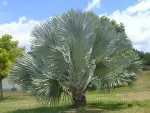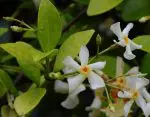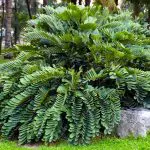This post contains affiliate links. If you buy something from one of our links we may earn a commission. Thanks

Transform your home into a tropical paradise with our guide to growing and decorating with the Christmas Palm indoors. Discover the beauty today.
Growing Christmas Palm indoors requires a well-lit spot away from direct sunlight, with temperatures between 65-80°F. It thrives in a well-draining soil mix like one containing peat moss, perlite, and sand.
Water it when the top inch of soil feels dry and ensure good drainage to prevent root rot. Applying a slow-release palm fertilizer every three months during the growing season will support its growth.
Are you looking for a way to add a touch of paradise to your home? Look no further than the Christmas Palm indoors!
This stunning plant is not only easy to care for, but it also adds a pop of green and a tropical vibe to any space.
Whether you live in a city apartment or a suburban home, the Christmas Palm tree can transform any indoor area into a lush oasis.
In this post, we’ll share our tips and tricks for growing and decorating with the Christmas Palm indoors, so you can enjoy a little bit of paradise year-round.
What Is A Christmas Palm?
The Christmas Palm Adonidia merrillii belongs to the Arecaceae family and is a popular tropical plant that has become a favorite among indoor plant enthusiasts.
It is also known as the Manila Palm, Kerpis Palm, Adonidia Palm, Dwarf Royal Palm, Veitchia Palm, or Veitchia merrillii.
As you can see using the common name for a plant can be confusing so it is a better idea to buy plants by their scientific name.
With its stunning appearance and easy-to-care-for nature, the Christmas Palm has quickly become a must-have for anyone looking to add a touch of the tropics to their home decor.
The Christmas palm is named for the red fruit that covers the plant during the Christmas season. So it is a popular indoor decoration in some parts of the world.
In this blog post, we’ll dive into the characteristics of the Christmas Palm and why it’s a popular indoor plant, as well as provide an overview of what you can expect to learn about growing and caring for this beautiful plant indoors.
So, whether you’re an experienced plant parent or just getting started, keep reading to discover the beauty of the Christmas Palm indoors.
Christmas Palm Quick Facts
| Mature Height: | 8-10 ft Indoors 10-25 ft Outdoors |
| Mature Width: | 4-8 ft Indoors 5-10 ft Outdoors |
| Sunlight: | Full-Partial |
| Growth Rate: | Moderate |
| Botanical Name: | Adonidia merrillii |
| Grows Well In Zones: | 4-11 patio / 10-11 outdoors |
Buy your Christmas Palm (Adonidia merrillii) on Amazon
The Christmas Palm Plant Description

The Christmas Palm Adonidia merrillii is a small to a medium-sized palm tree that is native to the Philippines.
It is known for its slender, smooth gray trunk that is ringed by leaf scars, and its bright green leaves that grow in a feather-like pattern.
The tree gets its name from the clusters of bright red fruits it produces, which often ripen around Christmas time, hence the name Christmas Palm.
The plant can grow up to 20 feet tall in its natural habitat, but when grown indoors, it typically grows to a height of 6-8 feet.
Why the Palm Tree is a Popular Indoor Plant
The Christmas Palm Adonidia merrillii is a popular indoor plant for several reasons.
For one, its compact size makes it an ideal plant for smaller living spaces, such as apartments and condos.
Additionally, it is easy to care for and does not require as much light or as high a humidity level as some other tropical plants.
The Christmas Palm is also popular for its aesthetic appeal, with its bright green leaves and striking red fruit adding a pop of color and tropical flair to any room.
What You Will Learn In This Post
In this post, we’ll cover all aspects of growing and caring for the Christmas Palm Adonidia merrillii indoors.
We’ll start with an overview of the plant’s characteristics, including its size and appearance, as well as its native habitat.
From there, we’ll move into the specifics of growing Christmas Palm indoor palm trees, including lighting, temperature, soil, and watering requirements.
We’ll also discuss care and maintenance, such as pruning and pest prevention, as well as tips for repotting and transplanting the plant.
Finally, we’ll touch on how to decorate with the Christmas Palm, including placement ideas and holiday decorating options.
Whether you’re a seasoned plant parent or a newbie, we hope you’ll find this guide useful for bringing a little bit of the tropics into your home with the Christmas Palm indoors.
Characteristics of the Christmas Palm or Adonidia merrillii
The Christmas Palm is a stunning tropical plant that has quickly become a popular indoor plant for its aesthetic appeal and easy-to-care-for nature.
In this section, we’ll take a closer look at the characteristics of the Christmas Palm, including its size and shape, the appearance of its leaves and fruit, and its native environment.
Understanding the characteristics of the Christmas Palm is important for growing and caring for this beautiful plant, so whether you’re a new plant parent or a seasoned pro, keep reading to discover all there is to know about the Adonidia palm.
The Appearance of the Leaves and Fruit
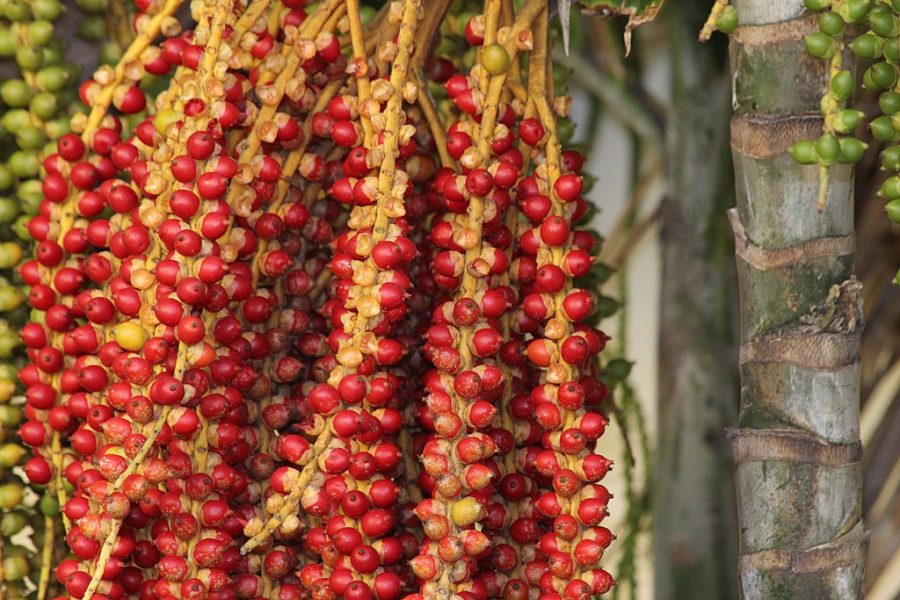
The leaves of the Christmas Palm Adonidia merrillii are bright green and grow in a feather-like pattern.
They are pinnate, meaning they have a central stalk with numerous leaflets branching off from either side.
The leaflets are narrow and pointed, giving the plant a delicate appearance.
The Christmas Palm also produces clusters of bright red fruits that are about 1 inch in diameter.
The leaves grow in a feather-like pattern and can reach a length of up to 5 feet, giving the plant a graceful and tropical appearance.
The tree gets its name from the clusters of bright red fruits it produces, which often ripen around Christmas time, hence the name Christmas Palm.
The fruits are edible but not commonly consumed, and are mainly used for ornamental purposes.
Native Environment of the Christmas Palm
The Christmas Palm tree is native to the Philippines and is commonly found in coastal regions and lowland forests.
Here it is fairly common outdoors in South Florida.
The plant is well adapted to warm and humid environments, but can also tolerate slightly cooler temperatures.
In its natural habitat, the Christmas Palm can grow up to 20 feet tall but is often shorter in cultivation.
The plant is a popular ornamental in tropical regions and is also grown for its edible fruit in some areas.
Overall, the Christmas Palm is a beautiful and versatile plant that brings a touch of the tropics wherever it is grown.
III. Growing the Christmas Palm Indoors

If you’re looking to bring a touch of the tropics into your home, the Christmas Palm is a great choice.
The stunning Christmas tree palm has become popular as indoor plants due to its compact size, easy-to-care-for nature, and striking appearance.
In this section, we’ll dive into the specifics of growing the Christmas Palm indoors, including lighting, temperature, soil, and watering requirements.
Whether you’re a seasoned plant parent or a newbie, understanding the basics of growing the Christmas Palm is key to keeping it healthy and thriving.
So let’s get started and learn all about growing the Christmas Palm Adonidia merrillii indoors!
Lighting Requirements for this Palm Plant
The Christmas Palm thrives in bright, indirect light. It prefers a location near a window that receives bright but filtered light.
However, it’s important to avoid direct sunlight as it can burn the leaves.
If your home does not receive sufficient natural light, you can supplement it with artificial grow lights to ensure your plant thrives.
It’s true that the Christmas Palm can tolerate full sun exposure for 6-8 hours a day, especially when the fruits are ripening.
It can also tolerate some partial shade.
However, it’s important to gradually acclimate the plant to direct sunlight and to avoid exposing it to the intense sun during the hottest part of the day.
Providing some shade during the hottest part of the day can also help prevent leaf burn.
Overall, it’s important to monitor your Christmas Palm and adjust its light exposure as needed to ensure it stays healthy and happy.
Indoors you can use a grow light if bright light is scarce.
Temperature and Humidity Needs
Adonidia merrillii thrives in warm, humid environments. It prefers temperatures between 65-80°F, making it an ideal indoor plant.
In terms of humidity, the Christmas Palm will benefit from increased humidity levels, which can be achieved through regular misting or by placing the plant on a tray of pebbles filled with water.
Alternatively, a humidifier can be used to keep the air moist around the plant.
Soil and Fertilizer Requirements
The Christmas Palm tree grows best in a well-draining potting soil mix that is high in organic matter.
A soil mix containing peat moss, perlite, and sand works well.
A mix of coco coir and perlite works equally well and provides a more environmentally friendly option without destroying peat bogs.
Fertilizer is important for the healthy growth of the plant, and a slow-release palm fertilizer should be applied every three months during the growing season.
Watering and Drainage Tips
The Christmas Palm prefers consistently moist but well-draining soil. It’s important to avoid over-watering, as this can lead to root rot.
Water your plant when the top inch of soil feels dry to the touch, and ensure that the pot has drainage holes to prevent water from accumulating in the bottom of the pot.
Avoid using tap water as it can contain harmful minerals that can damage the plant. Use filtered or distilled water to ensure the health of your Christmas Palm.
Soil Type and Watering for the Christmas Palm
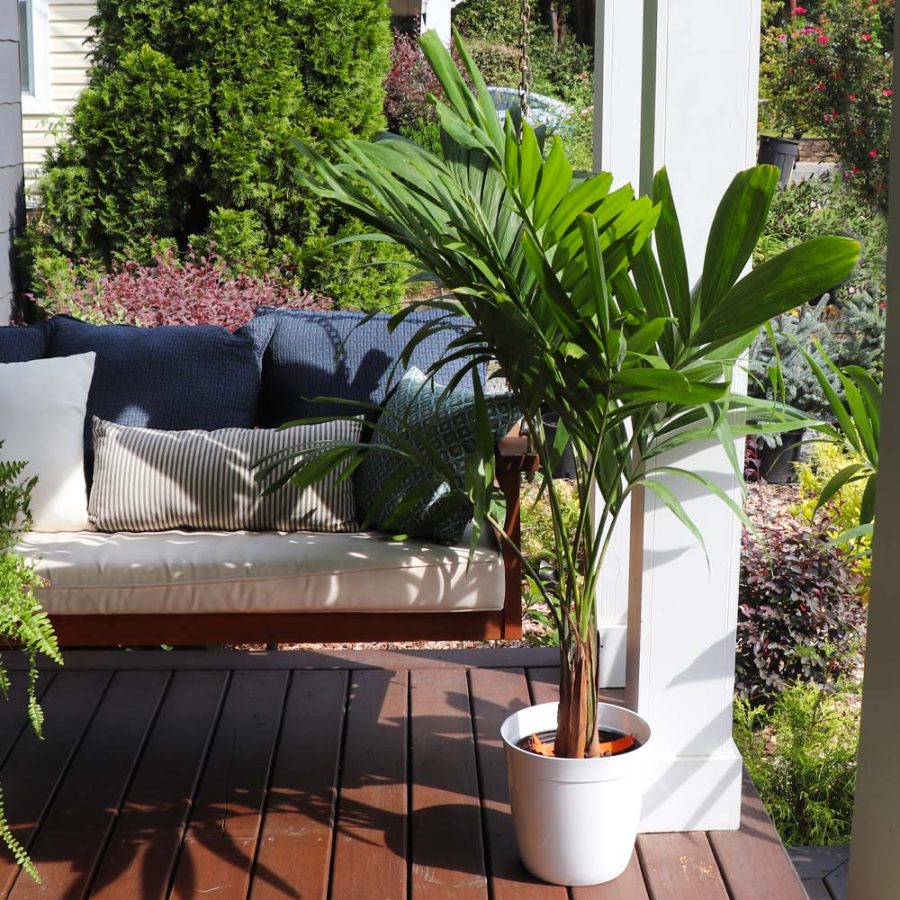
Soil Type
When growing the Christmas Palm indoors, it’s important to choose the right type of soil to ensure optimal growth and health.
The palm tree prefers well-draining soil that is rich in nutrients.
You can use a high-quality potting mix that is specifically designed for palm trees, or you can create your own mix using equal parts peat moss, perlite, and sand.
Coco coir and perlite mixes also provide good drainage for indoor palms.
The soil should be kept moist but not waterlogged, as the palm tree is sensitive to overwatering.
Watering
Proper watering is essential for the health and growth of the Christmas Palm.
The plant should be watered thoroughly once a week during the growing season, and less frequently during the winter months.
Be sure to let the soil dry out slightly between waterings to prevent overwatering, which can lead to root rot and other issues.
When watering, make sure to saturate the soil thoroughly, but avoid getting water on the leaves or trunk of the plant, as this can cause damage.
In addition to regular watering, you can also help improve the humidity levels around the plant by placing a tray of water near the plant or using a humidifier.
This can help prevent the plant from drying out and ensure that it remains healthy and vibrant.
By following these simple tips for soil type and watering, you can help ensure that your Christmas Palm Adonidia merrillii thrives and adds a touch of tropical beauty to your indoor space.
Temperature and Humidity Requirements for the Christmas Palm
Temperature
The Christmas Palm or Adonidia merrillii is a tropical plant and thrives in warm climates, and humid environments.
It prefers temperatures between 65°F and 85°F (18°C to 29°C) and can be sensitive to extreme fluctuations in temperature.
Cold weather can harm your new palm and cold temperatures of 30° or lower can kill it.
To keep your Christmas Palm healthy and happy, try to maintain a consistent temperature in your indoor space, and avoid placing the plant near cold drafts or areas with temperature extremes, such as windows or air conditioning units.
Humidity
In addition to warm temperatures, the Christmas Palm also requires high humidity to thrive. This can be a challenge in indoor environments, especially during the dry winter months.
To help maintain the proper humidity levels, consider using a humidifier near your plant or placing a tray of water near the plant to help add moisture to the air.
You can also mist the leaves of the plant with a spray bottle to help increase the humidity directly around the plant.
By providing the right temperature and humidity conditions, you can help ensure that your Christmas Palm remains healthy and vibrant, and adds a touch of tropical beauty to your indoor space.
Care and maintenance of the Christmas Palm

The Christmas Palm is a relatively low-maintenance plant, making it a great choice for indoor gardening.
However, to ensure the long-term health and beauty of your palm, it’s important to provide it with proper care and maintenance.
In this section, we’ll cover the basics of caring for and maintaining your Christmas Palm, including pruning, repotting, and pest control.
By following these simple tips, you can keep your Christmas Palm looking lush and vibrant for years to come.
So let’s dive in and learn how to care for and maintain the beautiful Christmas Palm.
Pruning and Trimming of the Plant
Adonidia merrillii requires minimal pruning and trimming, but it’s important to remove any dead or yellowing fronds regularly.
Use clean, sharp pruning shears to make a clean cut at the base of the leaf stem.
Avoid cutting into the trunk of the plant, as this can cause damage and make the tree more susceptible to pests and diseases.
Pest and Disease Prevention
The Adonidia merrillii is relatively pest and disease resistant, but it’s still important to keep an eye out for common issues such as spider mites, mealybugs, and scale insects.
Regularly inspect your plant for any signs of pests or diseases, such as yellowing leaves, sticky residue, or discolored spots.
If you notice any issues, isolate the plant and treat it with a natural or chemical insecticide as needed.
Repotting and Transplanting Guidelines
The Christmas Palm prefers to be slightly root-bound, so it’s not necessary to repot the plant frequently.
However, if the roots have outgrown the pot or the soil has become compacted, it’s time to repot into a larger pot.
Choose a pot size that is slightly larger than the current one, and use a well-draining potting mix.
You can add a slow-release fertilizer to the soil but make sure to follow the directions on the package.
If you use a large pot it could stay wet for too long and may cause root rot.
During the transplanting process, be careful not to damage the roots, and water the plant thoroughly after repotting to help it settle into its new home.
It’s best to repot in the spring or early summer months when the plant is actively growing.
Decorating with the Christmas Palm
In addition to being a beautiful indoor plant, the Christmas Palm can also serve as a stunning decorative element in your home.
Its unique shape and vibrant foliage make it a great choice for adding a touch of tropical flair to any space.
In this section, we’ll explore some creative ways to decorate with the Christmas Palm, including using it as a centerpiece, incorporating it into a living wall, or creating a lush, indoor oasis.
So whether you’re looking to add some natural beauty to your home or create a relaxing, tropical escape, the Christmas Palm is a versatile and eye-catching plant that is sure to impress.
Placement Ideas for the Plant in the Home
The Christmas Palm can be placed in a variety of locations throughout your home, depending on your personal preference and the plant’s light requirements.
Consider placing your palm in a well-lit corner or near a window that receives plenty of bright, indirect light.
You can also use your Christmas Palm as a focal point in a larger room, such as a living room or dining room.
Complimentary Decor and Furnishings
When decorating with the Christmas Palm consider using furnishings and decor that complement the plant’s tropical aesthetic.
Rattan or wicker furniture, colorful accent pillows, and natural wood or stone accents can all help create a relaxed, beachy vibe that highlights the plant’s unique beauty.
You can also use decorative pots or planters to add a pop of color or texture to your Christmas Palm display.
Holiday Decorating Options
The Christmas Palm is the perfect plant to incorporate into your holiday decorating scheme.
Its festive name and vibrant red fruits make it a great choice for adding some tropical flair to your Christmas decor.
Consider using your Christmas Palm as a centerpiece for your holiday table, or add some lights and ornaments to create a unique and eye-catching holiday tree.
You can also use your palm as part of a larger holiday display, such as a living wall or indoor oasis, for a truly stunning and memorable decoration.
Christmas Palm FAQs:
Indoor plants bring a burst of nature into our living spaces, providing not only aesthetic pleasure but also a calming ambiance.
The Christmas Palm, with its tropical appeal, is a popular choice among indoor plant enthusiasts. However, like with any plant, growing it indoors comes with a set of questions regarding its care, maintenance, and growth requirements.
Below, we have compiled a list of frequently asked questions to guide you on your journey of turning your home into a tropical paradise with the Christmas Palm.
Q. What is the ideal temperature for growing a Christmas Palm indoors?
A. The Christmas Palm prefers temperatures between 65°F and 85°F (18°C to 29°C). It’s crucial to keep it away from cold drafts or areas with extreme temperature fluctuations.
Q. How often should I water my Christmas Palm?
A. Water your Christmas Palm when the top inch of soil feels dry to the touch. The frequency may vary, but usually, thorough watering once a week during the growing season is adequate.
Q. What type of soil is best for a Christmas Palm?
A. A well-draining soil mix rich in organic matter is ideal. A mix of peat moss, perlite, and sand, or alternatively, a mix of coco coir and perlite works well for the Christmas Palm.
Q. How do I deal with pests on my Christmas Palm?
A. Regular inspection for pests like spider mites, mealybugs, and scale insects is essential. If you notice any pests, isolate the plant and treat it with a natural or chemical insecticide as per the infestation level.
Growing Christmas Palm Indoors Final Thoughts
In conclusion, the Christmas Palm Adonidia merrillii is a beautiful and popular indoor plant that can add a touch of tropical beauty to any indoor space.
With the right care and maintenance, this palm tree can thrive and remain healthy for many years.
By understanding the characteristics, growing requirements, and care guidelines for the Christmas Palm, you can help ensure that your plant remains vibrant and adds a unique touch to your home decor.
Whether you’re a seasoned plant enthusiast or just starting out, the Christmas Palm Adonidia merrillii is a great choice for anyone looking to add a touch of the tropics to their indoor space.
Recap of the Key Points
The Christmas Palm is a beautiful and popular indoor plant that is native to the Philippines.
It is characterized by its slender trunk, graceful fronds, and bright red fruit, which ripen in the winter.
The Christmas Palm is a popular indoor plant due to its low maintenance requirements, tropical beauty, and adaptability to a variety of indoor spaces.
To successfully grow this plant indoors, it is important to provide the right lighting, temperature, humidity, and soil conditions, as well as regular watering and fertilization.
Christmas Palm (Adonidia merrillii) as an Indoor Plant
Adonidia merrillii is a great choice for anyone looking to add a touch of the tropics to their indoor space.
It is a hardy and low-maintenance plant that can thrive in a variety of indoor environments.
With its striking appearance and adaptability, the Christmas Palm is a great option for both experienced plant enthusiasts and beginners alike.
Why Not Grow the Christmas Palm
If you’re looking to add a unique and beautiful plant to your indoor space, the Christmas Palm Adonidia merrillii is a great choice.
By following the guidelines outlined in this post, you can successfully grow and care for this beautiful plant, and enjoy its tropical beauty year-round.
Whether you’re looking to add a touch of holiday cheer or simply want to enjoy the lush beauty of a tropical plant, the Christmas Palm Adonidia merrillii is sure to delight and impress.
So why not give it a try and bring a touch of the tropics to your indoor space today?
Buy your Christmas Palm (Adonidia merrillii) on Amazon
Read more: Indoor Palm Tree Care: 11 Powerful Tips Complete Guide For Beginners




